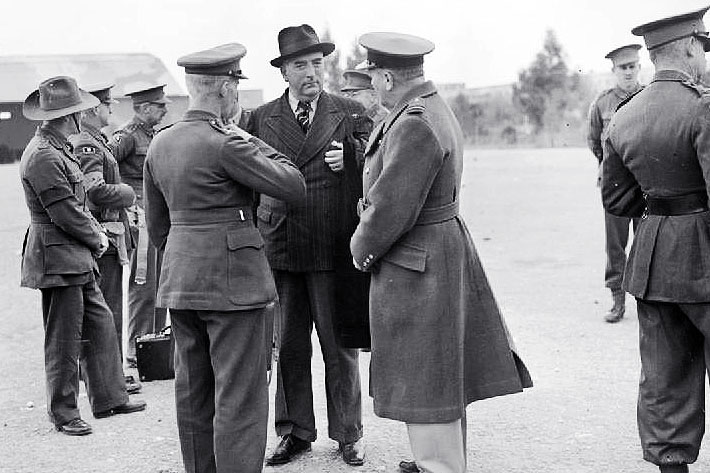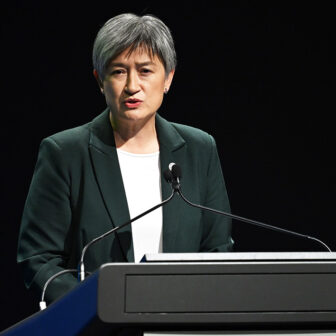A few years ago, going through the papers of former prime minister Sir Robert Menzies at the National Library of Australia, I came across some intriguing correspondence tucked away in a folder of official souvenirs. The exchange of letters — surely a fragment of a larger and longer conversation — shone light on an ancient quarrel between Menzies and the Melbourne Club, bastion of the Victorian conservative establishment.
In the early 1930s, Menzies was a member of the so-called Group, a circle of men, mainly financiers and business figures, who together coaxed Joseph Lyons away from the Labor Party to head up a new conservative force under the banner of the United Australia Party, or UAP. Lyons led the UAP to victory at the 1931 federal election, and Menzies became attorney-general when he was elected to federal parliament in 1934. But not all the glittering prizes would be his. While other members of the Group were ushered into the Melbourne Club in the mid 1930s, Menzies was not invited, apparently because of his failure to enlist in the first world war.
In May 1939, a former president of the club, Sir Frank Clarke, wrote to Menzies, who had just become prime minister after Lyons’s sudden death, offering to organise his nomination for membership. “It should have been years ago,” Clarke wrote. His note confirmed that Menzies’s failure to serve in the armed forces during the first world war was held against him by members of the club who had fought in that conflict. Anyone aware of the history of Australian gentlemen’s clubs would have assumed that to be the case, but to see it confirmed so candidly in ink, in the hand of one of the leading establishment figures of the day, was a eureka moment. I felt like I’d struck archival gold. The question was whether Clarke’s diplomatic overture fully explained why the club had previously snubbed Menzies.
But why, in the troubled year of 2017, would we want to solve the mystery of a dusty dispute between various members of Melbourne interwar elites? Amy Milne-Smith, author of the cultural history London Clubland, provides eloquent justification: “While rich white men have arguably been the focus of historical research since its inception, it is often only their most public lives that are examined.” Probing the internal dynamics of ruling elites, she writes, can reveal distinctions of gender and class “in some of the most meaningful ways. Particularities of status and masculinity were minutely worked out in the society of clubmen as they fought to exclude women and monitor the actions of men.” Studying the history of elite clubs can reveal much about the hidden workings of power in past generations, and how they contributed to shaping contemporary society.
As it turns out, elite machination was indeed a factor in Menzies’s snubbing by the Melbourne Club. While he had supporters among liberal conservatives inside the club, and even among some of the more reactionary conservatives, Menzies was opposed by a powerful faction whose mouthpiece was Melbourne’s conservative morning newspaper, the Argus. This group set itself against him for reasons that certainly involved, but went beyond, his failure to enlist. Political enmities and old personal loyalties were also in the mix, as I explore further in a recent article in Australian Historical Studies.
Menzies was well aware of the Argus faction’s opposition to him – it was reflected in the newspaper’s editorials. In his letter responding to Sir Frank, he expressed gratitude for Clarke’s support, but prevaricated about the offer. What happened to this proposal in the months following is not yet publicly known. Perhaps the official club history now being written will reveal the full story. Suffice to say that at Menzies’s death in 1978, obituarists who reached for Who’s Who in Australia would have found the Melbourne Club missing from the extensive list of club memberships against his name.
Menzies was just one of thousands of Australian men whose age put them in the window for military service in the first world war, but who nevertheless failed to volunteer. Understanding how the question “But did he enlist?” divided Australians during and after the war has been a significant preoccupation among historians of twentieth-century Australia. Much of the focus has fallen on the dynamic at work between the establishment and the working class, on “the perception and reality of unequal sacrifices demanded of working-class families and communities, and the restrictions placed on their ability to speak out in protest against them,” as historian Judith Smart has written.
Menzies’s treatment by the Melbourne Club provides a broader insight into how the establishment used the idea of fitness for membership also to enforce its priorities among highly successful middle-class men who might consider joining a club or a lodge. Under the guise of imperial loyalty, conservatives policed middle-class opinion, not only to reinforce conservative state and federal governments, but apparently for their own ends as well.
Much of the recent scholarship on gentlemen’s clubs has been undertaken by women scholars working through frameworks such as the history of masculinity. Complete outsiders to the world of men’s clubs as they are, they explore its insider/outsider dynamic with a freedom not available to their male colleagues. Their work highlights how elite machinations excluded all but the most senior ranks of civil service and army from the most prestigious clubs, and also demonstrates how whiteness was used as a yardstick of suitability for membership. Fascinatingly, it also brings to life the personal ordeal of club members or candidates for membership who found themselves, peremptorily and apparently inexplicably, on the outer.
As Barbara Black writes in A Room of His Own, a literary history of London clubland, “the privileges of membership have little to do with quaint notions of fine cigars, a rollicking game of whist, and comfortable armchairs; instead, they take us right to the tortured heart of identity construction.” Menzies’s treatment at the hands of the Melbourne Club faction that deployed the Argus editorial columns against him in the late thirties no doubt informed his strong public embrace of middle-class identity in the early 1940s. •




